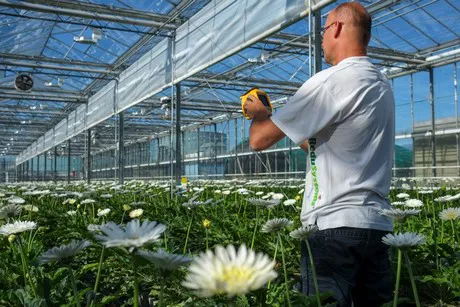Plants consist for the most part of water, so they are quickly warmed up by infrared radiation. Water absorbs infrared very well. The quality of flowers and plants is adversely affected if it becomes too warm. Reflecting infrared radiation before it enters the greenhouse therefore has a large impact on plant temperature. Coatings influence sunlight and heat to optimize climate conditions for the crop inside the greenhouse.
All radiation above a wavelength of 700 nanometres (nm) is called infrared. A plant does not use infrared for photosynthesis, but the plant is warmed due to the properties of water. Blue, green, red and far red pass straight through water but infrared heats it up, especially above 1200 nm. Therefore, on a nice sunny day, the crop warms up considerably. On such a day the plant temperature heats up even more than the greenhouse air.
Limits to the heat
The fact the crop warms up is beneficial to all kinds of plant processes within a certain range. But there are limits. The combination of lots of light, a high crop temperature and low humidity leads initially to a halt in photosynthesis and eventually to actual damage like discoloration, leaf burns and spots.
Even before the plant approaches the fatal range it can be very useful to limit the rise in plant temperature. Then the crop transpires less so the window vents can be closed for longer. In this way, you retain more CO2 in the greenhouse which results in more growth. With some crops, such as chrysanthemum and gerbera, flower colour can be improved by avoiding over-heating.

The right coating
Coatings are a very good way to keep out infrared radiation. They can be applied to the roof for the months that infrared radiation is not desired and removed when heat becomes beneficial again.
- ReduSol causes the largest amount of light and heat reflection, thereby protecting the crop from heat stress and burns.
- ReduHeat separates the radiation of PAR light and infrared. ReduHeat keeps out the heat radiation from the sun, while transmitting grow light into the greenhouse.
- ReduFuse IR diffuses the light and reduces heat radiation entering the greenhouse, lowering leaf temperatures and improving crop quality.
- ReduFlex Blue also reflects heat but to a lesser degree. ReduFlex Blue reflects more blue light and heat, resulting in a longer stem length of roses for example.
Crop strategy
Reflecting the incoming heat has big advantages but there are also some other effects to consider. The crop warms up more slowly in the morning, which may require extra heating from the pipes during spring. Another point is that infrared has a direct effect on the head of the crop. This is the most temperature sensitive of all the plant organs. It quickly warms up and the speed of development (shooting of leaves) rises with temperature. This means that infrared gives an advantage in winter because it accelerates growth. In summer, however, there is too much infrared which can cause actual damage. The infrared reflective coating slows down the speed of development. This is not a problem in the summer, but it needs to be taken into account in the spring and autumn with respect to the timing of application and removal.
For more information visit www.redusystems.com or stop by the ReduSystems booth (B5.24) to get your personalized coating advice.
